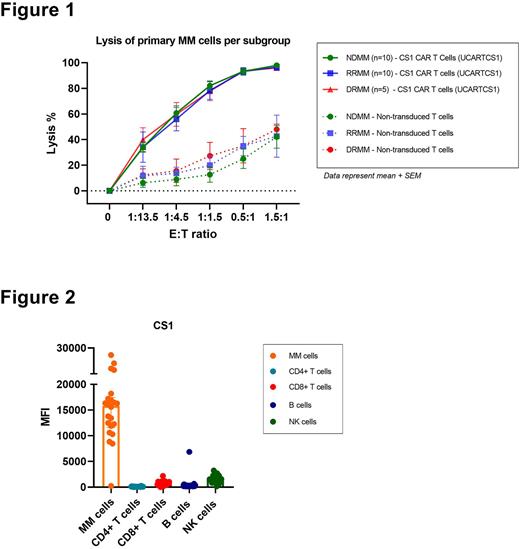Abstract
Introduction: The substantial activity of chimeric antigen receptor (CAR) T-cells in multiple myeloma (MM) has recently been shown by the success of BCMA-CAR T-cell therapy. Nevertheless the difficulties in (timely) generation of CART cells for each patient, the limited availability of manufacturing slots, and the frequent BCMAlow MM relapses after therapy urge the investigators to search for i) alternative, "off the shelf", available sources of CAR T-cells and ii) alternative target antigens than BCMA.
UCARTCS1 cells are "off the shelf" allogeneic CAR T-cells derived from healthy donors targeting CS1 (SLAMF7), which is a highly attractive target, due to its overexpression on MM cells. Furthermore, the genes coding for the TCRα chain of the TCRab receptor and for CS1 are disrupted in UCARTCS1 cells using Cellectis' TALEN® gene-editing technology. These modifications aim to minimize the potential risk for allo-TCR-mediated graft-versus-host disease (GvHD) upon infusion in patients and diminish CS1-mediated fratricide.
In this study, we evaluated the preclinical activity of UCARTCS1 in MM cell lines, in bone marrow (BM) samples obtained from MM patients and in a MM mouse model. We also investigated the potential impact of previous therapy and tumor characteristics on the in vitro efficacy of UCARTCS1.
Methods: Luciferase-transduced MM cell lines with different expression levels of CS1 were incubated with UCARTCS1 cells or control (non-transduced CS1/TCRαβ double knock-out) T-cells at different E:T ratios for 24 hours. MM cell lysis was assessed by bioluminescence. Anti-MM activity of UCARTCS1 was also evaluated in 25 BM samples obtained from newly diagnosed (n=10; NDMM), daratumumab-naïve relapsed/refractory patients (n=10; RRMM; median of 3 prior therapies) and from daratumumab-refractory patients (n=5; DRMM; median of 3 prior therapies) in 24-hour flow cytometry-based cytotoxicity assays. The results were correlated to CS1 expression levels of MM cells, Treg frequency, and several other patient characteristics such as treatment history.
Results: UCARTCS1 induced strong CS1 CAR-mediated and dose-dependent lysis of different MM cell lines expressing variable levels of CS1 (MM1s, L363, UM9, U266). UCARTCS1 cells also effectively lysed primary MM cells in a dose-dependent and CAR-mediated manner, with a mean maximal lysis of 96.9% (Figure 1). In these BM samples, UCARTCS1 cells also targeted CS1+ non-malignant hematopoietic cells, such as CD4+ T-cells, CD8+ T-cells, B cells, and NK cells, while sparing the CS1low fraction in each cell subset. However, the lysis of normal cells was less efficient than MM cell lysis, which could be explained by substantially lower CS1 expression on normal cells compared to MM cells (Figure 2). CS1 expression on MM cells and UCARTCS1 cytotoxic activity were both comparable in the different patient subgroups. In addition, baseline tumor and immune characteristics, such as the expression level of CS1 on MM cells, the tumor load (MM cell percentage in BM), or frequency of Treg cells in the BM did not affect CAR T-cell mediated cytotoxicity.
Finally, UCARTCS1 exhibited durable dose-dependent anti-MM activity in mouse xenograft models after i.v. injection of CAR T-cells compared to mice treated with CAR- control T-cells.
Conclusion: UCARTCS1 has potent anti-MM activity against MM cell lines and primary MM cells, as well as in a MM xenograft model. There was no difference in activity between heavily pretreated and newly diagnosed patients, indicating that mechanisms of resistance to prior therapies do not result in reduced susceptibility to UCARTCS1-mediated lysis in vitro. UCARTCS1 was also effective in samples from patients with relatively low CS1 expression, with high tumor burden, or with high Treg numbers. These data support the ongoing phase 1 clinical trial with UCARTCS1 in heavily pretreated MM patients (NCT04142619).
Disclosures
Le Clerre:Cellectis: Current Employment. Chion-Sotinel:Cellectis: Current Employment. Zweegman:Sanofi: Membership on an entity's Board of Directors or advisory committees; Janssen: Membership on an entity's Board of Directors or advisory committees, Research Funding; Takeda: Membership on an entity's Board of Directors or advisory committees, Research Funding; BMS: Membership on an entity's Board of Directors or advisory committees; Oncopeptides: Membership on an entity's Board of Directors or advisory committees. Galetto:Cellectis: Current Employment. Mutis:Takeda: Research Funding; Genmab: Research Funding; Janssen: Research Funding. Van De Donk:Novartis: Membership on an entity's Board of Directors or advisory committees, Research Funding; Roche: Membership on an entity's Board of Directors or advisory committees; Amgen: Membership on an entity's Board of Directors or advisory committees, Research Funding; Servier: Membership on an entity's Board of Directors or advisory committees; Cellectis: Research Funding; Takeda: Membership on an entity's Board of Directors or advisory committees; Adaptive Biotechnologies: Membership on an entity's Board of Directors or advisory committees; Celgene: Membership on an entity's Board of Directors or advisory committees, Research Funding; Bristol Myers Squibb: Membership on an entity's Board of Directors or advisory committees, Research Funding; Bayer: Membership on an entity's Board of Directors or advisory committees; Janssen Pharmaceuticals: Membership on an entity's Board of Directors or advisory committees, Research Funding.
Author notes
Asterisk with author names denotes non-ASH members.


This feature is available to Subscribers Only
Sign In or Create an Account Close Modal